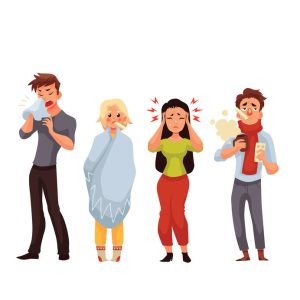Have you been suffering too many colds this season? Is your “healthy” exercise program compromising your immune system? Or is exercising while you are under the weather sabotaging your workouts?
Let’s face it: the gym can sometimes be a double-edged sword. For the most part, exercise will boost a client’s energy level as well as his or her immune system. However, if that client is suffering from the typical colds and flu to which we all succumb at this time of year, is exercise necessarily the best course of action?
The Exertion Effect
Aspects of our immune system react adversely following a heavy workout, such as the skin, upper respiratory tract, lung and muscle tissue, and the bloodstream. A majority of exercise immunologists feel that during this window of inopportunity after intense exercise, viruses and bacteria may gain a foothold, elevating the risk of contracting an infection.
This risk amplifies exponentially when other factors compromise immune function: exposure to new pathogens, lack of sleep, or emotional stress. This belief was conceived in the early 1990s following a study conducted by David Nieman, Ph.D. Dr. Nieman introduced what he referred to as the “J-shaped curve”, illustrating how regular moderate exercise may decrease the risk of upper respiratory infections while regular intense exercise may increase one’s susceptibility.
Knowing When To Back Off
Mild to moderate physical activity is considered safe even in the presence of a common cold, provided there is no accompanying fever. Exercise may even temporarily relieve mild congestion by opening nasal passages. Endorphin release often adds to the temporary feeling of improved well-being.
If a client’s symptoms are above the neck — runny nose, sore throat or sneezing — most physicians endorse mild to moderate exercise. However, when symptoms occur below the neck, such as wheezing, coughing or gastric distress, prudent athletes might consider skipping the gym —and the spreading of germs — and opting for rest. Even under mild illness circumstances, reducing the intensity of a workout will still provide some exercise while not placing the body at risk for a more serious and/or debilitating cold or infection.
The Sum Total of a Client’s Health
While it seems tempting for trainers to encourage clients to “work through” their symptoms, in an effort to maintain a regular weekly client load/income level, sage advice suggests taking a longer view than simply the next paycheck. We have dedicated ourselves to the preservation and improvement of clients’ physical wellbeing, and that does not always mean bigger muscles or improved VO2 max.
Keep in mind that the client is not alone in the gym; rather, exercising when sick threatens the health of all gym patrons as well as the trainer, who comes into particularly close contact when spotting and assisting clients. Considering the entire person rather than his or her individually trained body parts, we must know when it is best to suggest rest and a day or two off from the gym, and when it might be appropriate to carry on with business as usual. Becoming familiar with which aspects of intensity can ramp up or depress the body’s immune function enables us to provide the best possible guidance to our clients.
References:
webmd.com/cold-and-flu/cold-guide/exercise-when-you-have-cold#1-2
livestrong.com/article/331034-does-exercise-weaken-immune-system/
ncbi.nlm.nih.gov/pubmed/17414793
mayoclinic.org/healthy-lifestyle/fitness/expert-answers/exercise/faq-20058494
Cathleen Kronemer is an NFPT CEC writer and a member of the NFPT Certification Council Board. Cathleen is an AFAA-Certified Group Exercise Instructor, NSCA-Certified Personal Trainer, ACE-Certified Health Coach, former competitive bodybuilder and freelance writer. She is employed at the Jewish Community Center in St. Louis, MO. Cathleen has been involved in the fitness industry for over three decades. Feel free to contact her at trainhard@kronemer.com. She welcomes your feedback and your comments!

